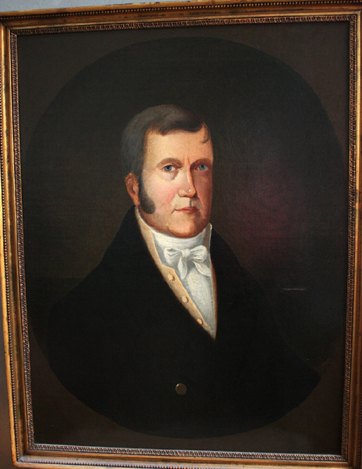
When Stanley Clark Bagg (SCB) and his father, Stanley Bagg, of Montreal, visited England in 1842, they were combining business and pleasure. The business involved selling property that SCB’s maternal grandfather had owned in Durham, England, and the pleasure involved a whirlwind tour of London, Scotland, Ireland and France, as well as visits with various great-aunts and great-uncles who still lived in England.
It was a good time for a trip: SCB had just finished a four-year apprenticeship with a notary and could now practice as a notary himself. It made sense to travel before he opened his own office.
A few months after his return to Montreal, SCB wrote to his cousin in Philadelphia, outlining the trip. Unfortunately, he did not include any details or impressions of their adventures, but the list of places they visited sounds exhausting. Passenger rail services were expanding in England at the time, but much of their travel would have been done by horse-drawn coach.
Crossing the Atlantic, however, was fast. The age of the trans-Atlantic steamship had arrived in the 1830s, and SCB wrote, “We made the passage to Liverpool from Halifax in the incredible short space of nine days and six hours, which was I believe the shortest passage ever made across the Atlantic. From Liverpool we went to London, thence to Leeds, Manchester, Birmingham, York Darlington, Durham, Stockton, Sunderland, Newcastle, Shields, Tynemouth, Otterburn …. ” 1
As they moved north to Scotland, they passed though many small towns, including Lesmahagow, and they explored both Glasgow and Edinburgh. On the way back to London, they stopped in Carlisle, in the north of England.
After a few days in London, they crossed the Channel to France, where they visited Boulogne, Paris, Versailles, Le Havre and several other spots before returning to London. SCB wrote, “We left London shortly afterwards for Ireland, and having visited Kingstown, Dublin and Kilmainham, returned to Liverpool, where … we embarked on board a steamship and after a boisterous passage of 14 days arrived at Boston exceedingly gratified with our tour.” 2
Anchor-maker William Mitcheson, brother of SCB’s grandmother Mary Mitcheson Clark, lived in London, and the Baggs visited him there. While in County Durham, they visited more Mitcheson relations, including Mrs. Dodd (Mary Mitcheson’s sister Margaret) near Ryton, and Mrs. Maugham (Mary’s sister Elizabeth) at Sunderland.
It is clear that the visit to Durham was the highlight of the trip, but not because of the business they finalized there. In fact, SCB did not mention the land sales at all in his letter. When SCB turned 21 in December, 1841, he gained control over the property he had inherited from his grandfather John Clark (1767-1827). This property was generating rental income, but SCB wanted to sell it. Proof that the sale took place can be found in a notarized document, dated after their return to Montreal, in which Stanley Bagg listed the sales of three properties in Durham. 3

Meanwhile, SCB was interested in ancient legends, old coins, Norman castles and the like, and was enthralled with Durham. More than 20 years later, he presented a lecture to the Numismatic and Antiquarian Society of Montreal on “The Antiquities and Legends of Durham.” 4
He described the legend surrounding the founding of Durham city by 9th century monks. When Danes attacked England’s northeast coast, the monks fled their monastery on the Island of Lindisfarne with the miraculously well-preserved body of their former bishop. Eventually they built an abbey at the future site of Durham city and buried him there. Today, that bishop is remembered as Saint Cuthbert and pilgrims still visit the abbey church, Durham Cathedral.
In his 1866 lecture to the Numismatic Society, SCB opened up about his feelings on the trip. He recalled, “The first time I had the privilege of attending a divine service in Durham Abbey, I was enraptured with the sweet and masterly chanting, unsurpassed in the empire. My father and I obtained seats in the choir. The service was exceedingly impressive, so much so, that …. whenever the portion of the Psalter chanted upon that occasion recurs in the services of the church, it carries me back in imagination to the first service I attended in the venerable abbey of my mother’s native city.” 4
This story is also posted on https://.genealogyensemble.com
See also:
Janice Hamilton, “A Freehold Estate in Durham,” Writing Up the Ancestors, May 3, 2019 https://www.writinguptheancestors.ca/2019/05/a-freehold-estate-in-durham_92.html
Janice Hamilton,“Mary Mitcheson Clark,” Writing Up the Ancestors, May 16, 2014, https://www.writinguptheancestors.ca/?p=164
Janice Hamilton,“Mary Ann (Clark) Bagg,” Writing Up the Ancestors, Nov. 29, 2013, https://www.writinguptheancestors.ca/?p=187
Janice Hamilton,“The Mitcheson Family of Limehouse,” Writing Up the Ancestors, Jan. 21, 2015, https://www.writinguptheancestors.ca/?p=147
Janice Hamilton, “Stanley Bagg’s Difficulties,” Writing Up the Ancestors, Jan. 10, 2014, https://www.writinguptheancestors.ca/2014/01/stanley-baggs-difficulties.html
Sources
- Letter from Stanley Clark Bagg to Rev. R. M. Mitcheson, Dec. 6, 1842, probably transcribed by Stanley Bagg Lindsay; Lindsay family collection.
- Record in a passenger list of Stanley Bagg and S.C. Bagg travelling from Liverpool to Boston aboard the Acadia. Boston Courier (Boston, Massachusetts, Monday, Sept. 19, 1842, issue 1921;) 19th Century Newspapers Collection, special interest databases, www.americanancestors.org (accessed April 18, 2019.)
- Joseph-Hilarion Jobin, “Account and mortgages from Stanley Bagg Esq to Stanley Clark Bagg,” 8 October 1842, notarial act #3537, Bibliothèque et Archives nationales du Québec.
- Stanley Clark Bagg, “The Antiquities and Legends of Durham: a Lecture before the Numismatic and Antiquarian Society of Montreal,” p. 21, Montreal, 1866. https://archive.org/details/cihm_48731/page/n4 (accessed Dec. 27, 2019) SCB’s article can also be found here: http://www.canadiana.ca/view/oocihm.48731/1?r=0&s=1




